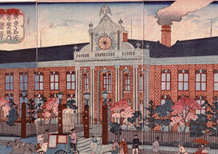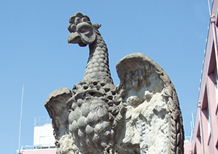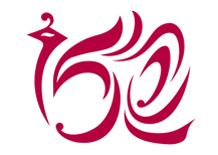History
The National Printing Bureau was founded on July 27, 1871 (Meiji 4) as the Paper Money Office (Shiheishi) under the Ministry of Finance, and in August the same year it was renamed the Paper Money Bureau (Shiheiryo). The services undertaken by the Bureau during the initial years of its foundation were general affairs under the government's paper money policy, including the issuance and exchange of paper money and the licensing and nurturing of national banks (privately-managed banks).
In those days, technology suitable for printing modern banknotes was not yet well developed in Japan, so the Meiji Government consigned the production of paper notes to Germany and the United States. As calls for the domestic production of paper money grew, it was decided that the Paper Money Bureau should make efforts to produce paper money domestically. In January 1872 (Meiji 5), the scope of the Bureau's work was formally extended to include printing and papermaking services, ranging from the production of paper money, and securities and postage stamps, to typographic printing.
On October 15, 1877 (Meiji 10), the Paper Money Bureau began producing Japan's first home-made paper money -- a one-yen National Banknote called “Shinken” or “New Note” -- thus taking the first step as a pioneer in modern printing and papermaking in Japan, in reality as well as in name.
The Paper Money Bureau merged on January 1, 1898 (Meiji 31) with the Official Gazette Bureau, which was engaged in the issuance of the Official Gazette -- first published on July 2, 1883 (Meiji 16) -- thus starting anew as an operational Bureau.
After a number of transitions in organizational status, in April 2003 (Heisei 15) the Bureau took a new step forward as an incorporated administrative agency, its present status.
Since its foundation, the National Printing Bureau has responded to public trust, by providing a stable and secure supply of products required by the national economy, utilizing the advanced anti-counterfeiting measures, efficient production technologies, and strict manufacturing control systems it has innovated through its own research and development.
The Bureau's continuing aim is to contribute to society through maintaining the high levels of expertise and trust for which it has come to be known worldwide.
History of the Organization
| Year | Date | Event |
|---|---|---|
| 1871(Meiji 4) | Jul. 27 | Founded as the Paper Money Office (Shiheishi) under the Ministry of Finance |
| 1871(Meiji 4) | Aug. 10 | Renamed the Paper Money Bureau (Shiheiryo) |
| 1872(Meiji 5) | Sep. 20 | Printing Bureau (Inshokyoku) was established in the Central Office of the Grand Council of the State (Dajokan Seiin) |
| 1875(Meiji 8) | April | Papermaking Bureau (Shoshikyoku) (currently Oji Plant) was established |
| 1875(Meiji 8) | Sep. 4 | Paper Money Bureau (Shiheiryo) merged with the Printing Bureau (Inshokyoku) to become the Paper Money Bureau under the control of the Ministry of Finance |
| 1876(Meiji 9) | Apr. 5 | Papermaking Bureau (Shoshikyoku) (currently Oji Plant) began operation |
| 1876(Meiji 9) | Oct. 10 | Printing plant was completed in Otemachi, Tokyo |
| 1877(Meiji 10) | Jan. 11 | Renamed the Paper Money Bureau (Shiheikyoku) |
| 1877(Meiji 10) | - | Manufactured Japan's first domestically-produced paper money (a one-yen National Banknote called “Shinken” or “New Note” which was issued on December 28) |
| 1878(Meiji 11) | Dec. 10 | Renamed the Printing Bureau (Insatsukyoku) |
| 1883(Meiji 16) | May. 10 | Document Bureau was established in the Grand Council of the State (Dajokan) |
| 1883(Meiji 16) | Jul. 1 | Manufactured the first Official Gazette (issued on July 2) |
| 1885(Meiji 18) | Dec. 22 | Document Bureau under the jurisdiction of the Grand Council of the State was renamed the Cabinet Document Bureau |
| 1885(Meiji 18) | Dec. 24 | Cabinet Document Bureau was renamed the Cabinet Official Gazette Bureau |
| 1898(Meiji 31) | Nov. 1 | Merged with the Official Gazette Bureau, and placed under Cabinet jurisdiction |
| 1909(Meiji 42) | Mar. 18 | Research Institute was established |
| 1923(Taisho 12) | Sep. 1 | Head Office building and the plant were destroyed by the Great Kanto Earthquake (In December, a temporary building was completed) |
| 1924(Taisho 13) | Dec. 20 | Renamed the Cabinet Printing Bureau (Naikaku Insatsukyoku), after government reorganization |
| 1931(Showa 6) | May. 16 | Takinogawa Annex (currently Tokyo Plant) was completed |
| 1941(Showa 16) | May. 24 | Sakawa Plant (currently Odawara Plant) was established |
| 1943(Showa 18) | Jun. 1 | Shizuoka Plant was established |
| 1943(Showa 18) | Nov. 1 | Became the Printing Bureau (Insatsukyoku) under the control of the Ministry of Finance |
| 1944(Showa 19) | Jan. 19 | Saidaiji Plant (currently Okayama Plant) was established |
| 1944(Showa 19) | Oct. 1 | Hikone Plant was established |
| 1945(Showa 20) | Jun. 22 | Takefu Plant was established |
| 1946(Showa 21) | August | Head Office and Otemachi Plant moved to Ichigaya (renamed Ichigaya Plant in the next month) |
| 1947(Showa 22) | Aug. 30 | Takefu Plant began operation |
| 1949(Showa 24) | Jun. 1 | Became an independent agency of the Ministry of Finance, and renamed the Printing Agency (Insatsucho) |
| 1952(Showa 27) | Mar. 31 | Takefu Plant was closed |
| 1952(Showa 27) | Aug. 1 | Became an affiliated organization of Ministry of Finance, and renamed the Printing Bureau, Ministry of Finance (Okurasho Insatsukyoku) |
| 1963(Showa 38) | Apr. 16 | Ichigaya Plant was renamed Toranomon Plant |
| 1984(Showa 59) | Jul. 1 | Became an extraordinary organization of the Ministry of Finance |
| 1992(Heisei 4) | Jul. 1 | Relocated the Research Institute to Odawara |
| 2001(Heisei 13) | Jan. 6 | In a reorganization of government ministries and agencies, the Japanese name of the Printing Bureau, Ministry of Finance became “Zaimusho Insatsukyoku” |
| 2003(Heisei 15) | Apr. 1 | Became an Incorporated Administrative Agency (Dokuritsu Gyosei Hojin), and renamed the National Printing Bureau (Kokuritsu Insatsukyoku) |
| 2014(Heisei 26) | Apr. 1 | Tokyo Plant was established by merging Toranomon Plant and Takinogawa Plant |
About the Bureau's Mark (Hōō)
The Hōō (Chinese phoenix) is a mythological bird in Chinese lore. The design of the Hōō was adopted for the paper money issued in 1872 (Meiji 5) and is also found on the reverse side of the current 10,000 yen note.
In 1876 (Meiji 9), Ryosuke Tokuno, Head of the Paper Money Bureau at that time, built a printing plant at the Paper Money Bureau (Shiheiryo) of the Ministry of Finance in Otemachi, Tokyo, and a stone Hōō about two meters in height was placed on the roof of the plant. The building, which was modern at that time, was also called “Choyokaku” and drawn in color woodblock prints as a symbol of civilization and enlightenment.
Although the Choyokaku was destroyed by the Great Kanto Earthquake in 1923 (Taisho 12), the stone figure of the Hōō is still stored in the Tokyo Plant of the National Printing Bureau and is the symbol of the Bureau.
 The newly built printing plant ofthe Paper Money Bureau (From a colored woodblock print)
The newly built printing plant ofthe Paper Money Bureau (From a colored woodblock print)
 The stone figure of the Hōō in Tokyo Plant
The stone figure of the Hōō in Tokyo Plant
 The Bureau's mark
The Bureau's mark


